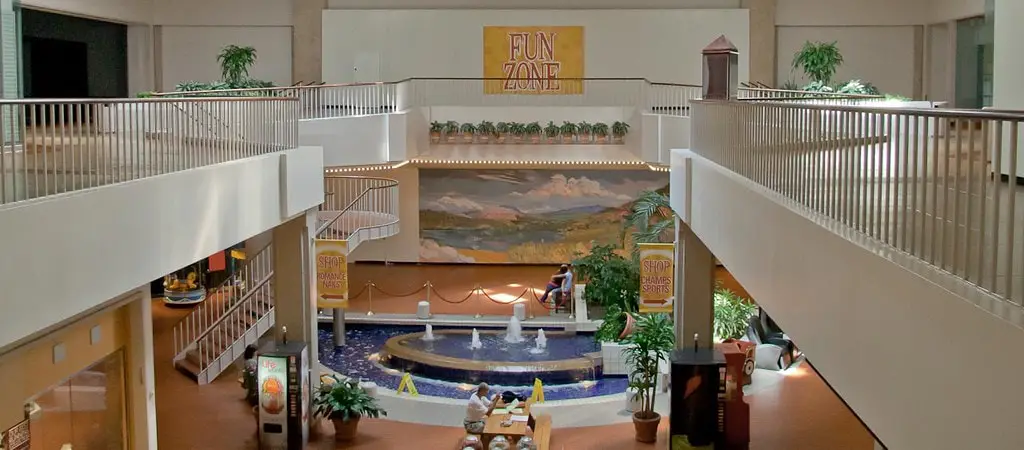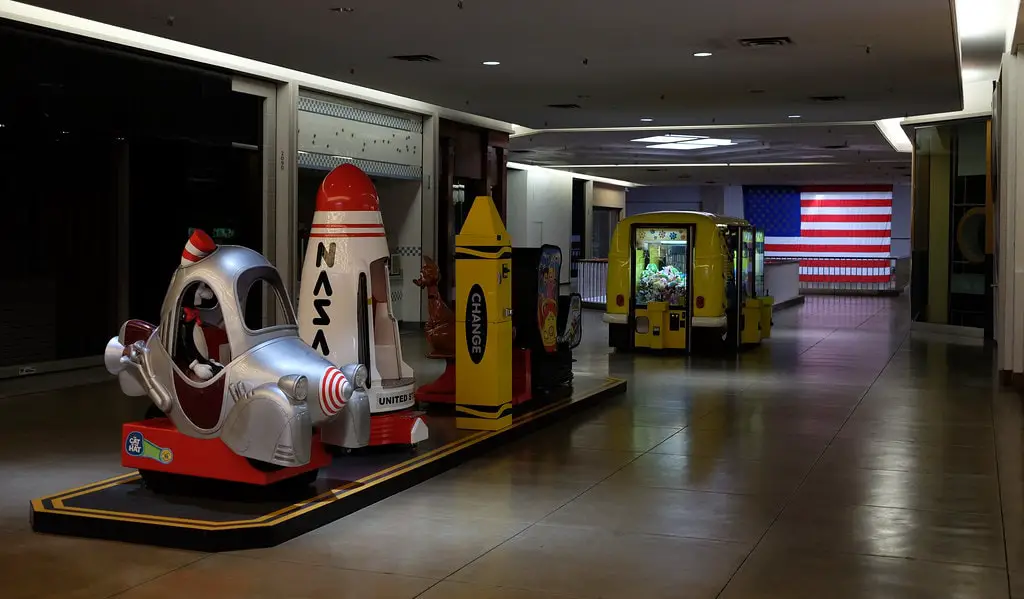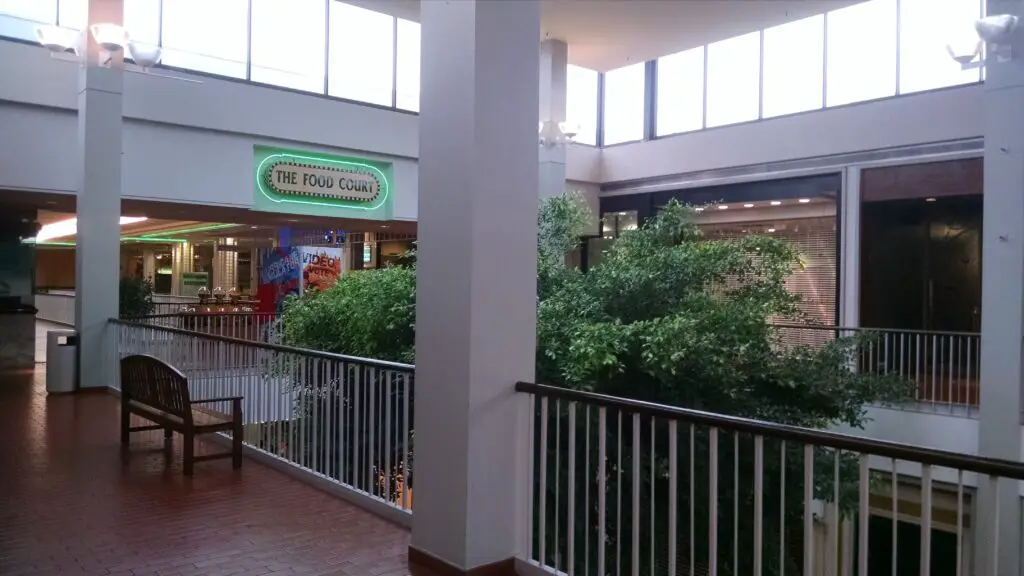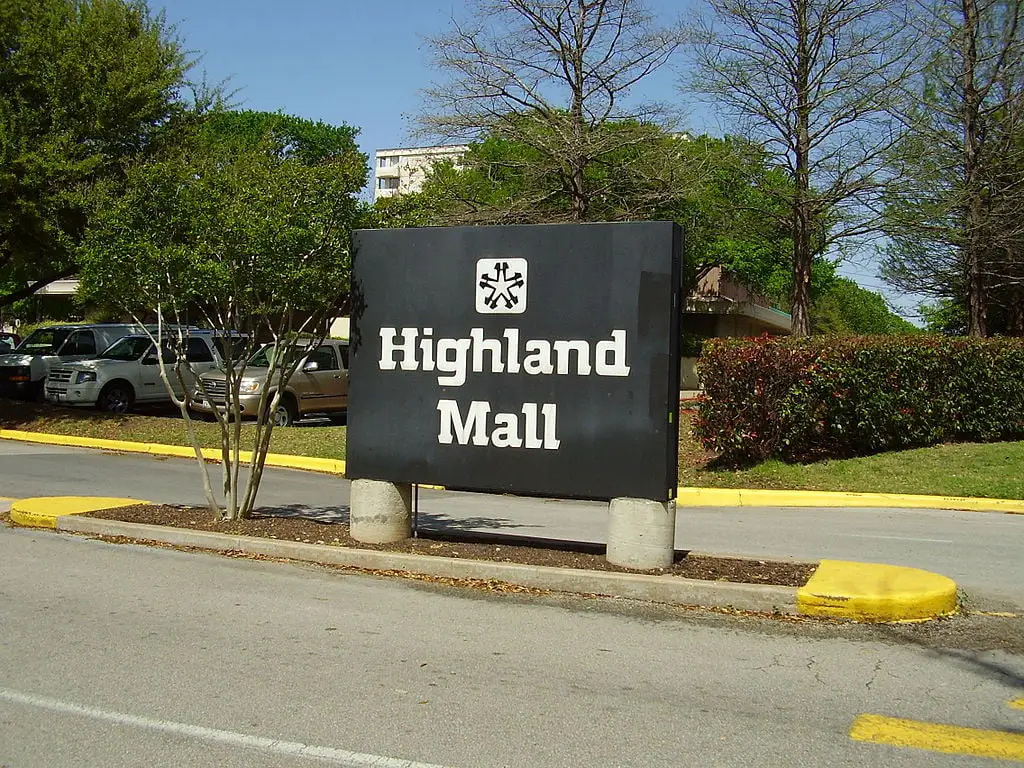The Dawn of Highland Mall: Austin’s Retail Revolution
The Inaugural Days of Austin’s First Suburban Mall
In Austin, Texas, a retail revolution began with the grand opening of Highland Mall on August 4, 1971.
Developed by Austin Malls Inc., a subsidiary of the renowned Rouse Company, Highland Mall emerged as the first of its kind in the suburban landscape of Austin.
This marked a significant milestone in the city’s retail history, transforming the shopping experience for residents.
The mall’s launch was not merely an opening of another shopping center; it symbolized the advent of a new era in Austin’s commercial and social life.
Anchoring Success with Iconic Stores
Highland Mall initially boasted a trio of major anchor stores that drew crowds and set the tone for its success.
JCPenney, a household name in American retail, was one of the original anchors, bringing a legacy of quality and customer service.
Joining JCPenney was Scarbrough’s, an Austin-based department store known for its local charm and diverse offerings.
Joske’s, a San Antonio-based retailer, was completing the trio, adding a touch of regional flair to the mall’s retail mix.
Each store brought unique appeal, making Highland Mall a one-stop destination for various shopping needs.
A New Social Hub in North Austin
Beyond its commercial success, Highland Mall quickly became a social hub in north Austin. It was a place where families spent weekends, teenagers met with friends, and holidays were celebrated with festive decorations and events.
The mall’s design, with comfortable seating areas and an inviting atmosphere, encouraged visitors to linger and enjoy their time.
Highland Mall was more than a collection of stores; it was a community gathering place, a venue for events, and a significant contributor to the local culture.
As Highland Mall stands today, it reminds us of the ever-evolving nature of retail and community spaces.
For those looking for things to do in Austin, Texas, the story of Highland Mall offers a glimpse into the city’s rich commercial history and its transformation over the years.
Highland Mall’s Retail Evolution
Transition and Transformation of Anchor Stores
As the years progressed, Highland Mall witnessed significant changes in its anchor stores, a common phenomenon in the dynamic world of retail.
In 1987, Dillard’s, a well-known American department store chain, acquired Joske’s. This acquisition brought about a fresh wave of retail offerings and customer experiences.
Dillard’s, known for its wide range of merchandise and quality service, revamped the former Joske’s space, infusing new energy into the mall.
1992, another major shift occurred when Dillard’s opened a second store in the space formerly occupied by Scarbrough’s, further expanding its presence and influence within Highland Mall.

The Mall’s Physical Expansion and Renovations
Highland Mall didn’t just grow in terms of its store lineup; it also underwent physical transformations. Throughout its years of operation, the mall saw various renovation projects and expansions.
These developments were not only about adding more square footage but also about enhancing the shopping experience.
New sections were added, existing spaces were refurbished, and the overall ambiance of the mall was uplifted.
These changes were crucial in keeping the mall relevant and appealing in the face of evolving consumer preferences and the competitive retail landscape.
Highland Mall Anchor Stores: A Historical Overview
Highland Mall’s anchor stores played a significant role in its history, each contributing to the mall’s identity and appeal. Below is a table summarizing the key anchor stores and their timelines:
| Anchor Store Location | Original Tenant | Subsequent Changes | Closure Date |
|---|---|---|---|
| South End | Joske’s | Purchased by Dillard’s in 1987, transformed into Dillard’s Women | Closed in May 2009 |
| Central Area | JCPenney | Original tenant since 1971 | Closed on September 30, 2006 |
| North End | Scarbrough’s | Became Dillard’s Men in 1992 | Closed in 2011 |
| East Side | Foley’s | Renamed Macy’s in September 2006 after Federated Department Stores’ acquisition of May Company in 2005 | Closed in March 2011 |
Each of these anchor stores marked a distinct phase in Highland Mall’s evolution, reflecting broader trends in retail and consumer preferences.
From the original tenants like JCPenney to the transformations of Foley’s into Macy’s, these anchors were integral to the mall’s story.
Highland Mall’s Decline and Controversies
The Beginning of the Decline
The story of Highland Mall is not just about growth and success; it also encompasses a period of decline. By 2008, signs of this downturn became evident.
Two of the mall’s seven retail sectors had closed, signaling a shift in the mall’s fortunes. This decline was not an isolated event but a broader trend affecting many traditional malls across the United States.
Highland Mall, once a bustling center of commerce and social life in Austin, began to face challenges as consumer preferences shifted and competition from newer shopping destinations intensified.

Facing Controversies and Legal Challenges
A series of controversies and legal challenges further complicated Highland Mall’s decline. One significant issue arose during the Texas Relays, a major track and field event at the University of Texas at Austin.
The mall developed a reputation for attracting large crowds during this event, leading to allegations of racial discrimination and a less-than-welcoming attitude toward visitors, primarily younger African-American attendees.
In 2009, the mall’s decision to close several hours earlier than usual during the Texas Relays sparked protests from the local chapter of the NAACP and talks of a boycott.
This controversy highlighted the complex social dynamics at play and the mall’s struggle to navigate them.
The Impact of Surrounding Development
As Austin continued to grow and expand, the demographics of the neighborhoods surrounding Highland Mall remained relatively unchanged.
Once considered a prime shopping destination, the mall lost appeal as newer, more modern shopping centers emerged.
These developments, such as Barton Creek Square and The Domain, began to draw away clientele that once frequented Highland Mall.
This shift reflected the changing landscape of retail and consumer preferences in Austin, further contributing to the mall’s decline.
The Final Chapter: Highland Mall’s Closure
The Countdown to Closure
Highland Mall’s story approached its final chapter as the calendar pages turned. Once a bustling hub of activity and commerce, the mall faced an inevitable closure.
In 2012, a significant blow came when the mall’s owners filed for bankruptcy, a clear indicator of the financial struggles the mall was enduring.
This event set the stage for the eventual closure of Highland Mall. By April 30, 2015, after 44 years of serving the Austin community, Highland Mall officially closed its doors.
This closure marked the end of an era for Austin’s first suburban shopping mall, leaving behind memories and a legacy that many would remember.

Reflecting on Community and Economic Impact
The closure of Highland Mall had a profound impact on the local community and economy. For decades, the mall had been a key player in Austin’s retail landscape, providing a space for shopping, socializing, and entertainment.
Its closure meant the loss of a community landmark and a significant change in the local economic fabric.
The mall had been a source of employment for many and a destination for shoppers all over the city. Its absence left a void in the community, felt by former employees, shoppers, and residents alike.
Nostalgia and Public Sentiment
As news of Highland Mall’s closure spread, nostalgia swept the city. Former shoppers and employees shared stories and memories of their time at the mall.
Highland Mall held a special place in the hearts of many; it wasn’t merely a shopping destination. It was a cherished spot where people created lasting memories, teenagers gathered, families shopped for holidays, and friends came together.
The mall’s closure ended a significant chapter in Austin’s retail history. Still, the memories and experiences it provided would live on in the hearts of those who had walked its corridors.
A New Beginning: Highland Mall’s Transformation by ACC
Austin Community College’s Visionary Acquisition
In a bold move that marked the beginning of a new era, Austin Community College (ACC) stepped forward to reshape the destiny of Highland Mall.
The transformation began in 2012 when ACC purchased the mall, envisioning it as a regional education center.
This acquisition was a real estate transaction and a visionary step towards repurposing a once-thriving retail space into an innovative educational hub.
ACC’s initiative reflected a growing trend of adaptive reuse in urban development, turning the former shopping mall into a beacon of learning and community engagement.
Redevelopment into a Cutting-Edge Educational Space
The metamorphosis of Highland Mall under ACC’s stewardship was remarkable. The first phase of the Highland Campus opened in Fall 2014, breathing new life into the former retail space.
This phase included state-of-the-art classrooms, laboratories, study areas, a library, and a media center.
A standout feature was the ACCelerator, a groundbreaking 600-station learning lab that offered individualized instruction through advanced technology.
This transformation was a testament to ACC’s commitment to innovation in education, providing a dynamic and modern learning environment for students.
Planning for the Future: Expansion and Potential
Highland Mall’s transformation journey continued with the initial redevelopment. ACC continued to plan for further expansion and innovation at the site. Plans included:
- A digital and creative media cluster.
- Expanded information technology programs.
- A culinary and hospitality center.
- Professional incubator space.
- An advanced manufacturing center.
- A workforce innovation center.
- A regional health sciences center with a simulator lab.
These plans aimed to create a comprehensive educational ecosystem, offering diverse opportunities for learning and development.
Under ACC’s guidance, the long-term vision for Highland Mall promised to redefine the role of academic spaces in urban settings.
Highland Mall’s Enduring Legacy and Influence
Shaping Austin’s Retail Landscape
Throughout its operational years, Highland Mall played a pivotal role in shaping the retail landscape of Austin, Texas.
Opened in 1971, it set a precedent as the city’s first suburban shopping mall, introducing a new retail and social space concept.
The mall’s influence extended beyond its physical boundaries, impacting shopping trends, consumer behavior, and urban development in Austin.
It served as a blueprint for future retail spaces, demonstrating the potential of malls as shopping destinations and community hubs.
The legacy of Highland Mall is evident in how shopping centers in Austin have evolved, blending retail with entertainment and social interaction.

Lessons from Highland Mall’s Rise and Fall
The story of Highland Mall offers valuable lessons in the fluid nature of commerce and urban development.
Its rise and fall mirror the broader trends in the retail industry, highlighting the importance of adaptation and innovation.
The mall’s initial success was due to its ability to meet the needs and preferences of its time. However, its decline serves as a reminder of the challenges traditional retail spaces face in an era of changing consumer habits and increasing competition.
The transformation of Highland Mall into an educational hub by ACC further underscores the need for flexibility and creativity in repurposing spaces.
